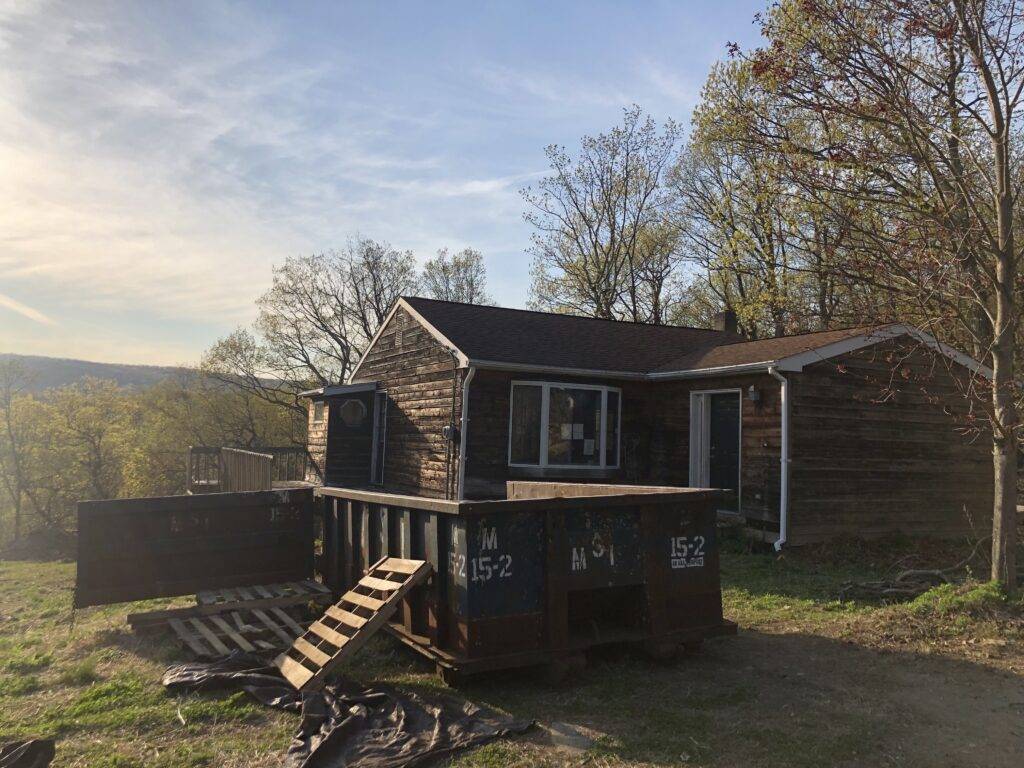Check out the rest of the Cabbage Dispatch series here.
Before I came upon The Cabbage, it sat empty for years, changing hands from contractor to contractor and eventually becoming a shelter for all kinds of creatures — including kids who enjoyed burning profanities into the ceiling. At a glance you could see that the copper plumbing had been ripped out and the electric wires had been cut. Pulling down panels of damaged sheetrock exposed hoards of acorns squirreled away and concerning amounts of mouse poop. I was beginning to wonder if we would run into the mouse colony when I found the reason we hadn’t – a black rat snake contentedly nesting in a wall between tufts of fiberglass insulation. It’s a strange day when you’re grateful snakes are living inside your house.
It’s a strange day when you’re grateful snakes are living inside your house.
And this was just on the main level. Downstairs, a slab of bedrock protruded into the room about waist-high. A previous owner had framed around it, creating a large stage-like surface carpeted in astroturf green. Once the “stage” was taken apart, I found more food caches, mouse skeletons, and actual living plant matter embedded in the rock crevices. The slab spanned a total of 20 feet — 10 feet outside and then 10 feet inside, effectively bringing the outside in. After brainstorming how to incorporate the rock into the interior design (rock bench, rock shower, rock shelves … you name it), it was clear that the only way to properly seal the house would be to remove as much of the rock as possible and frame around the fragments. Cue two weeks of diamond-bit drilling and experimenting with expanding cement.

The crew and I were three days into the demo when the dumpster arrived. A 15 foot steel rectangle was lowered into my front yard and became a very real reminder of the amount of C&D (construction and demolition) waste we were about to create. Having made a concerted effort to live a low-waste lifestyle for the last five years, this dumpster stood in direct opposition to my values. Determined to only use one dumpster for the demo phase, I started assessing the usability of everything that came off the house. The old pressure-treated deck boards were unsightly but sturdy, so we added them to the pile of new framing lumber. Instead of cutting up closet doors, trim, and baseboards, we slowly pried them loose and stored them for later. I spent hours on the ground with a hammer and crowbar, de-nailing 2x4s that could be used in new framing.
The goal was no longer to “demo,” but to deconstruct. There were real wins, like uncovering the original ’60s red oak parquet under layers of linoleum, plywood, and tile, as well as huge setbacks, like finding a section of the front rim joist (one of the beams that supports the house on the foundation) was being shredded by carpenter ants. And despite all the thoughtful efforts, the dumpster filled up. As did the second and third dumpsters — old drywall, mouse-infested fiberglass insulation, shingles, linoleum, ceramic tile, a jacuzzi tub, wall-to-wall carpet, and broken windows and toilets. This small house was a fire hose of waste that I couldn’t control. I felt like a failure. Why was the journey to making this home planet-friendly so unfriendly?
I remember a conversation I had when I was just starting on this renovation. A contractor came by to give me a quote on a new roof (something I hadn’t planned on, but mandatory if I wanted to add solar). He looked at the house, with sun-beaten siding and a chewed-up rim joist, and then at me, with dirty overalls and two hands full of splinters, and offered an unsolicited suggestion. “I’d just bulldoze the house and build something new.”
In this world of newness delivered to our doorsteps, salvaging something that others find worthless is a radical act.
In this world of newness delivered to our doorsteps, salvaging something that others find worthless is a radical act. Starting from scratch never occurred to me. There was only one way forward — to rescue, restore, and revive this forgotten home. To continue the arduous and sometimes backwards-looking process of picking up where others had left off. Not to make it perfect, but to make it better.


An (Incomplete) Inventory of Salvaged Materials
Reused
- Deck boards as wall and window framing
- Old wall framing lumber for new walls
- Two windows
- Entryway light fixture
- Parquet tiles
- Kitchen cabinets reinstalled in the shed
Donated
- Clamshell baseboard and trim
- Doors and door jambs
- Door knobs
- Shelving
Recycled
- Copper plumbing
- Furnace
- Baseboard heaters and covers
- 10x light cans
- Romex wire
- Steel door
- Broken appliances
- Buckets of old nails and screws





incredible and inspirational work, bea!
So helpful to know what to save! Thanks